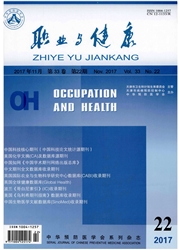

 中文摘要:
中文摘要:
目的通过流行病学调查探讨各年龄、性别在不同类型的燃煤性儿童氟骨症的分布情况和相关血清学指标变化,为儿童氟骨症发病机制研究提供思路。方法以贵州省织金县燃煤型氟中毒重病区为研究现场,对当地6-16岁儿童整群抽样,运用横断面调查研究方法研究不同特征的人群分布,并进行氟斑牙、X线检查和血清学检测。结果织金县燃煤型氟病区儿童氟骨症检出率为7.55%;不同年龄儿童的检出率差异有统计学意义(P〈0.05),10-〈13岁组和13-16岁组的检出率均高于6-〈10岁组(P〈0.05)。全血微量元素中钙、镁、铁、锌、铜等含量,氟骨症组和对照组之间差异均有统计学意义(P〈0.05);血清磷2组之间差异无统计学意义(P〉0.05)。正常儿童和氟骨症儿童血清中骨保护素(OPG)与碱性成纤维细胞生长因子(bFGF)含量的差异均有统计学意义(P〈0.05)。氟骨症硬化型与正常对照组之间OPG含量和bFGF含量的差异有统计学意义(P〈0.05)。结论氟骨症在织金县燃煤型氟病区儿童人群中的总检出率较高,检出率随年龄增长而增长。氟骨症儿童的全血微量元素由于氟改变骨代谢和细胞毒性的影响下降明显。氟骨症儿童的OPG与bFGF作为骨代谢血清标志物与对照组对比时分别下降和上升,特别是在硬化型的氟骨症少儿童中这种差异更加明显。
 英文摘要:
英文摘要:
[ Objective ] To probe into the distribution of coal burning fluorosis which may also affect children in age and sexuality by launching an epidemiological investigation followed by serological examination,provide new thoughts to the pathogenesis of fluorosis. [Methods] Zhijin District in Guizhou Province where coal-bunting fluorosis is widely prevalent was chosen as the objective field. By selecting a cluster sample of local children who were between 6-16 years old,the population distribution research was unfolded with the cross sectional research methods. Dental fluorosis test,X-ray examination and serological examination were carried out simultaneously. [Results] The prevalence rate of children with fluomsis in coal burning fluorosis area of Zhijin District was 7.55%. The difference in the prevalence rate was statistically significant among different age groups (P〈0.05),while the prevalence rates in the groups of 10-〈13 and 13-16 year-old was both higher than that in 6-〈10 year-old age group (P〈0.05). The contents of trace elements (Ca,Mg,Fe,Zn and Cu) in whole blood of children who suffered from skeletal fluorosis were lower than those of children in the control group,and the differences were statistically significant (P〈0.05). Meanwhile,there was no statistically significant difference in serum phosphorus between two group (P〉0.05). There were statistically significant differences in the contents of osteoprotegerin (OPG) and basic fibroblast growth factor (bFGF) between the skeletal fluorosis group and the control group (P〈0.05). There were statistically significant differences in the contents of OPG and bFGF between the group of sclerotic type of skeletal fluorosis and the control group (P〈0.05). [Conclusion] The total prevalence rate of fluorosis among children in coal burning fluorosis area of Zhijin District is high, and it increases with age. For the reason of physiological function of fluorine which is able to regulate bone metabolism and toxic to livi
 同期刊论文项目
同期刊论文项目
 同项目期刊论文
同项目期刊论文
 期刊信息
期刊信息
